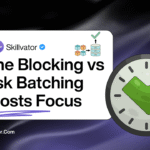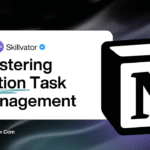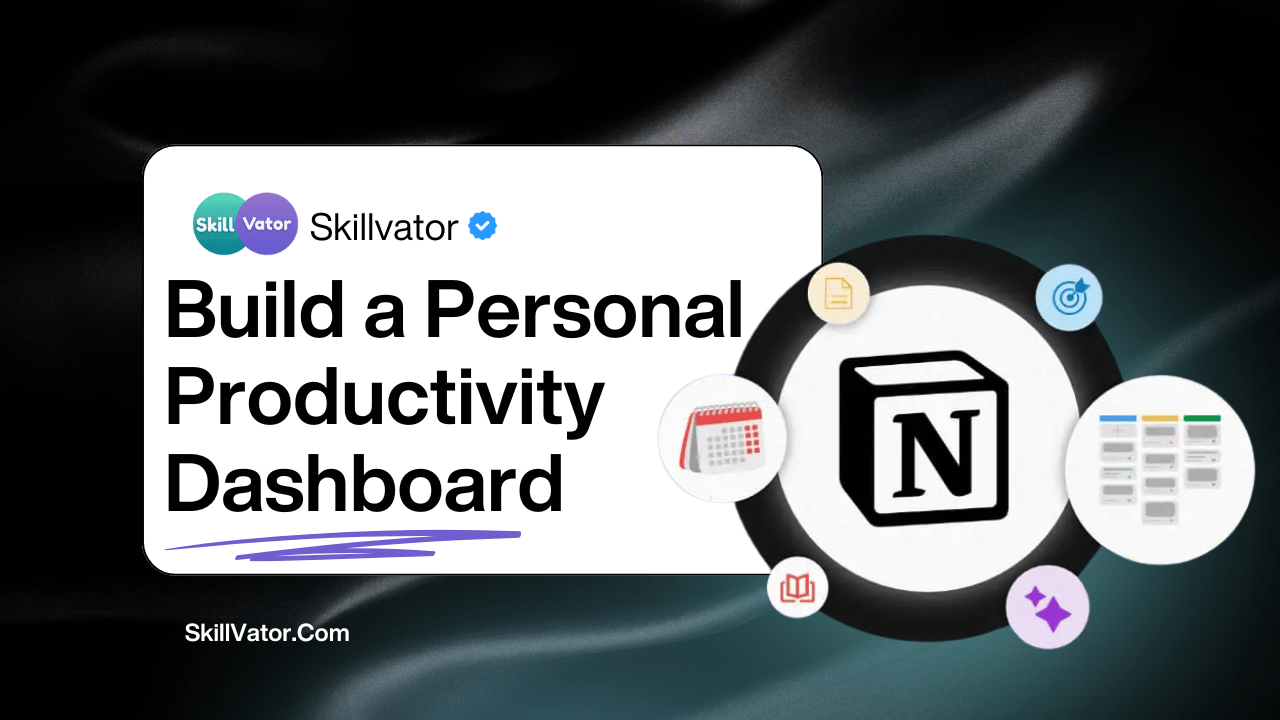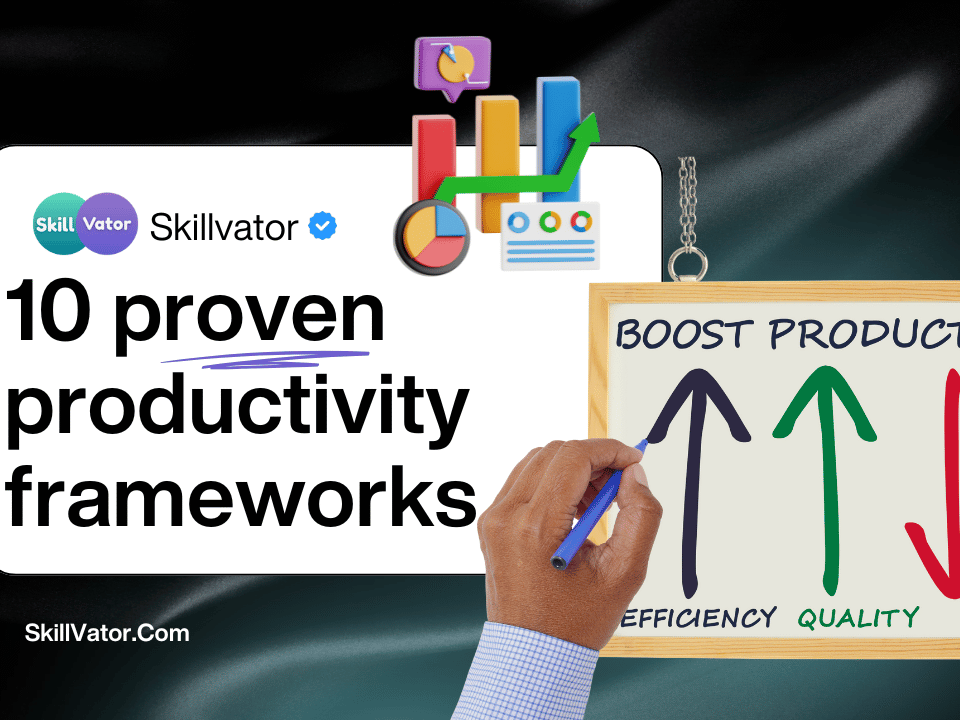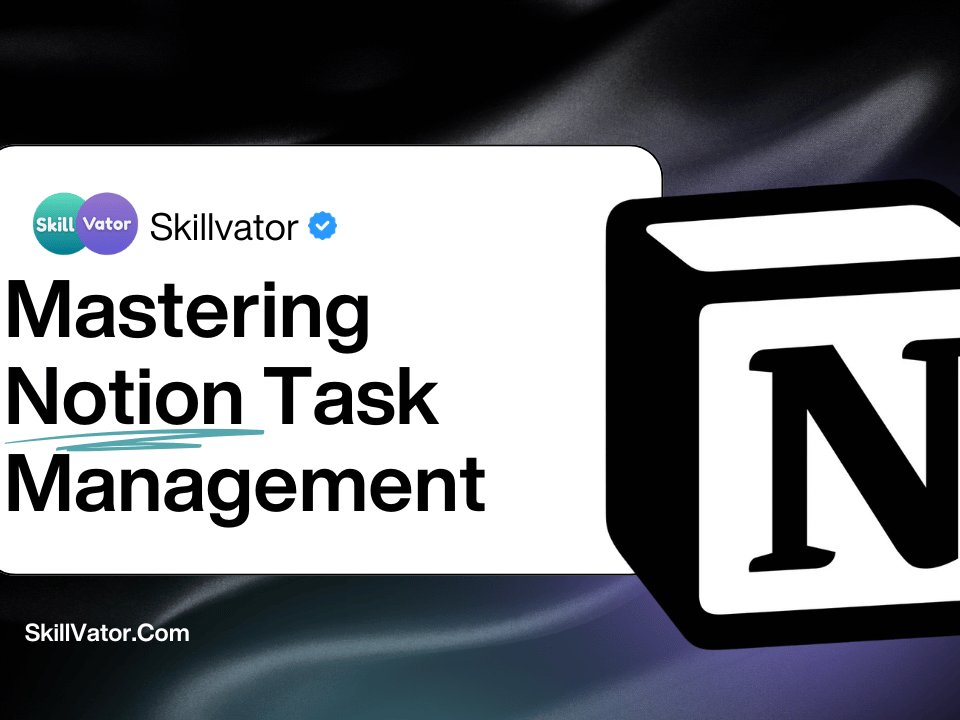Let’s be honest — productivity apps are everywhere. You’ve probably tried to-do lists, habit trackers, planners, and project management tools, only to end up with more clutter and less clarity.
That’s where Notion comes in — a fully customizable workspace that lets you design your own system, built around how you think and work.
At Skillvator, we believe productivity isn’t about doing more — it’s about doing better, with focus, purpose, and alignment. A Personal Productivity Dashboard in Notion brings all your goals, tasks, and priorities into one place — helping you manage your time, projects, and mindset seamlessly.
In this guide, you’ll learn exactly how to build your own dashboard — step-by-step — using Notion, with Skillvator-style simplicity and efficiency.
What Is a Personal Productivity Dashboard?
A Personal Productivity Dashboard is a central hub where you can track, plan, and manage every part of your workflow — from daily tasks to long-term goals.
Think of it as your control center for work and life. It connects all the dots:
-
✅ Daily task lists
-
🎯 Weekly priorities
-
🧭 Long-term goals
-
🗓 Projects & deadlines
-
💡 Notes, habits, and reflections
When built correctly, it helps you:
-
Focus on what truly matters
-
Reduce overwhelm and context switching
-
Measure progress clearly
-
Maintain balance between productivity and well-being
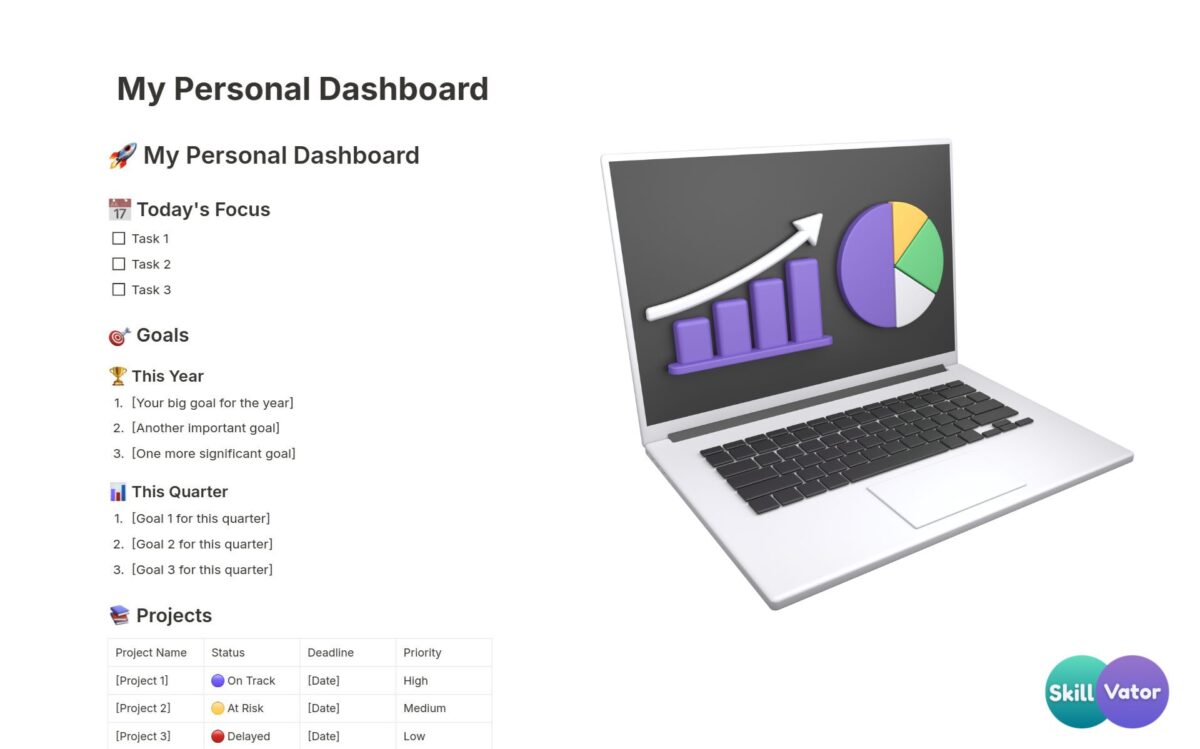
Why Use Notion for Productivity?
Notion is not just a note-taking app — it’s a modular workspace that adapts to your brain’s workflow.
Here’s why Skillvator recommends it for personal productivity systems:
| Advantage | Description |
|---|---|
| Customization | Create pages, databases, and templates that fit your goals. |
| All-in-One Hub | Combine tasks, goals, projects, notes, and even journaling. |
| Visual Clarity | Build clean dashboards with icons, covers, and linked views. |
| Integration Friendly | Connect to tools like Google Calendar, ClickUp, or Zapier. |
| Scalable | Start simple and evolve as your system grows. |
At Skillvator, we call Notion a “digital brain” — a single system that stores, organizes, and connects everything you need to perform at your best.
Before You Build: Define Your System
A dashboard only works when it aligns with your lifestyle and work style.
Ask yourself these Skillvator core questions before you start:
-
What are my key productivity goals?
(E.g., better focus, improved task tracking, balanced schedule) -
Which areas of my life do I want to manage?
(Work, personal life, learning, health, etc.) -
How do I prefer to see information?
(Minimal view, kanban board, list, or calendar?) -
What’s my biggest productivity challenge?
(Overwhelm? Forgetfulness? Lack of structure?)
Your answers will guide how your Notion dashboard looks and functions.
Step 1: Create a New Page for Your Dashboard
Open Notion and create a new page titled “Personal Productivity Dashboard.”
Add an icon (like ⚡ or 🎯) and a banner image that inspires you.
Then, choose “Empty with Icon” to start with a blank canvas.
This page will act as your central command center — where all your databases and linked pages live.
Skillvator Tip:
Use Notion’s “/columns” command to split the layout into two or three columns for a more professional, dashboard-like design.
Step 2: Add Core Sections
Your dashboard should reflect the three levels of productivity that Skillvator teaches:
| Level | Focus Area | Example |
|---|---|---|
| Micro | Daily execution | To-do lists, habits, focus sessions |
| Meso | Weekly planning | Priorities, meetings, progress tracking |
| Macro | Big-picture direction | Goals, vision, key results |
Let’s build each of these.
Step 3: Build the Daily Task Manager
-
Type “/database inline” → choose Table view.
-
Name it “📅 Daily Tasks.”
-
Add the following columns:
-
Task Name (Title)
-
Status (To Do / In Progress / Done)
-
Priority (Low / Medium / High)
-
Category (Work / Personal / Learning)
-
Due Date
-
Time Block (Morning / Afternoon / Evening)
-
You can then filter the database to show only today’s tasks:
-
Filter → “Due Date” → “is today.”
Now you have a clean, dynamic to-do list that updates daily.
Skillvator Tip:
Color-code your categories for quick scanning.
Example: Work = Blue, Personal = Green, Learning = Orange.
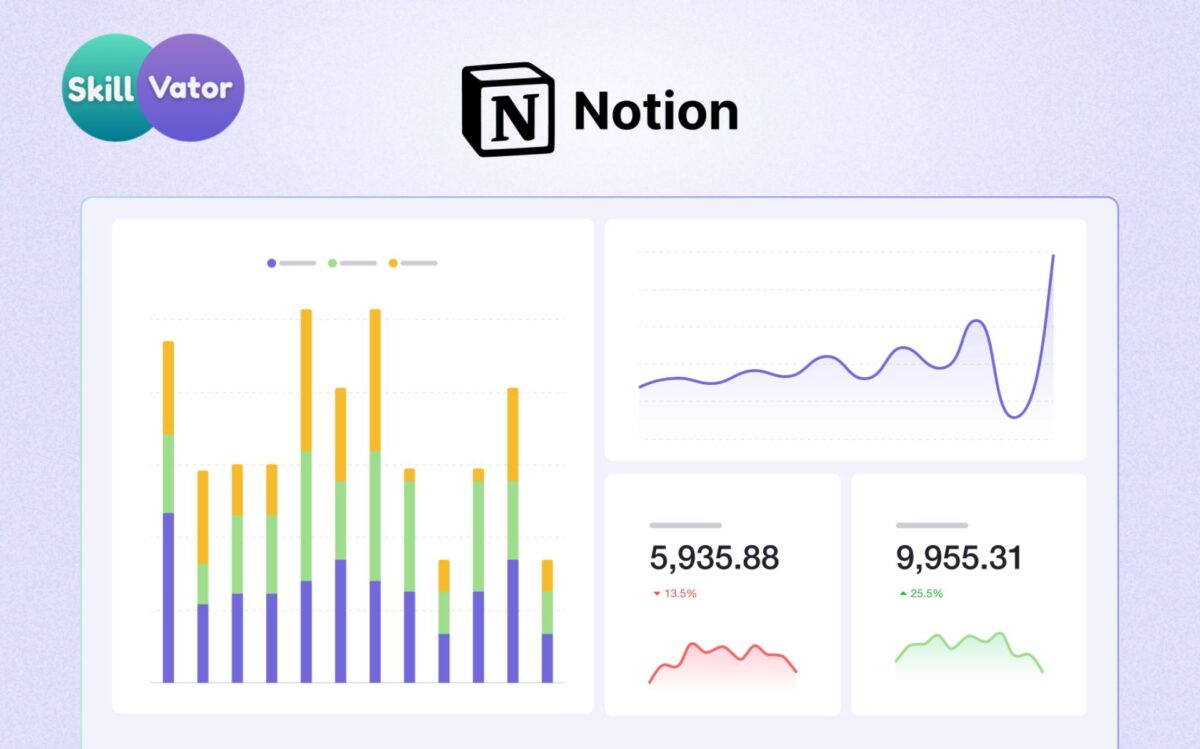
Step 4: Create a Weekly Goals Board
To stay focused, you need a clear overview of your priorities each week.
-
Create a new linked database (use “/linked database”).
-
Link it to your Daily Tasks database.
-
Add a new view → Board view → Group by “Week.”
Add properties like:
-
Week #
-
Main Focus
-
Wins / Challenges
Now, you’ll see your weekly goals grouped together visually — perfect for reviews and progress tracking.
Skillvator Tip:
Use Notion’s “Relation” property to connect your Weekly Goals board to your Daily Tasks table.
This way, when you complete tasks, your weekly progress updates automatically.
Step 5: Add a Project Tracker
Your projects deserve their own structured space.
Here’s how to create a simple yet powerful Project Tracker inside your dashboard:
-
Add a new database → name it “🚀 Projects.”
-
Add columns for:
-
Project Name
-
Status (Planning / In Progress / Complete)
-
Start Date / End Date
-
Related Tasks (Relation to Daily Tasks)
-
Priority
-
Goal Link (Relation to your goals database)
-
Use Gallery view or Board view for a clean, visual layout.
Now you can open any project card and instantly see its tasks, deadlines, and related goals — all in one place.
Step 6: Build a Goals & Vision Section
To make your system truly holistic, you need to link daily effort to long-term purpose.
Create a section titled “🎯 Goals & Vision.”
Inside, add a Table database with the following fields:
-
Goal Title
-
Timeframe (Q1, Q2, Yearly, etc.)
-
Category (Career, Personal, Learning)
-
Progress Bar (Rollup from tasks/projects)
-
Motivation / Why it matters
Link this database to your Projects and Weekly Goals tables.
Now, you can visualize how every small action connects to a bigger mission.
Skillvator Insight:
Most productivity systems fail because they isolate tasks from purpose.
When your tasks ladder up to goals, your focus becomes effortless.
Step 7: Add a Habit Tracker
Habits are the foundation of consistency — and consistency is what turns productivity into progress.
To build your habit tracker:
-
Add another inline database → “🔥 Habit Tracker.”
-
Columns:
-
Habit Name
-
Frequency (Daily / Weekly)
-
Status (Checkbox)
-
Category (Health / Work / Mindset)
-
Date
-
Then, add a Calendar View to visualize when you completed each habit.
Skillvator Tip:
Use Notion formulas to calculate streaks — e.g., how many days you maintained a habit.
Step 8: Add a Reflection & Review Section
Productivity without reflection is just motion.
Add a page or database called “🪞Weekly Reflection.”
-
Add questions like:
-
What went well this week?
-
What challenges did I face?
-
What did I learn?
-
What will I improve next week?
-
Create templates for weekly reflections with pre-filled prompts.
Why it matters (Skillvator Principle):
Reflection helps you recognize progress, reinforce positive habits, and adjust systems for better flow. It transforms productivity from hustle to growth.
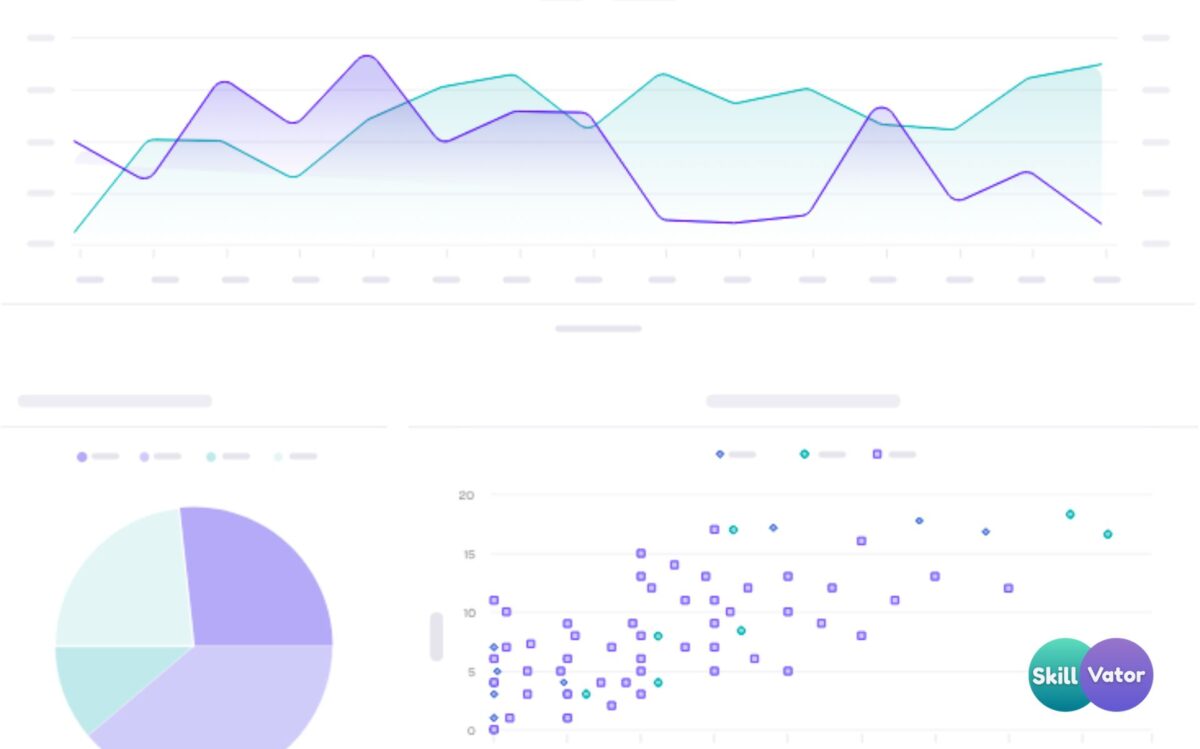
Step 9: Connect Everything — The Skillvator System
Now it’s time to connect all your sections into a unified dashboard.
-
Create navigation links at the top:
-
📅 Daily Tasks
-
🎯 Weekly Goals
-
🚀 Projects
-
🔥 Habits
-
🪞Reflection
-
Vision & Goals
-
-
Use linked databases so everything syncs dynamically.
-
Add a Progress Overview:
-
Create rollup fields in your goals database to summarize % completion of linked tasks/projects.
-
Your dashboard should now look like a professional productivity command center — clean, connected, and customizable.
Step 10: Style Your Dashboard
To make your dashboard inviting and inspiring:
-
Add emojis and icons to each section.
-
Use toggles to hide detailed sections.
-
Include motivational quotes.
-
Embed a calendar, YouTube focus playlist, or weather widget.
Skillvator Pro Tip:
Design matters — your dashboard should make you want to open it every morning.
Step 11: Automate with Integrations
Take your system to the next level by connecting Notion with automation tools:
| Integration | Use Case |
|---|---|
| Google Calendar | Sync meetings with task deadlines |
| Zapier | Auto-add new tasks from forms or emails |
| Readwise / Notion Sync | Import highlights from books & articles |
| Todoist + Notion | Merge external to-do lists into one dashboard |
Automation turns your dashboard from a manual system into a self-updating productivity engine.
Step 12: Maintain & Evolve Your Dashboard
The key to long-term success isn’t perfection — it’s iteration.
Every few weeks:
-
Archive old tasks
-
Adjust your categories
-
Simplify what feels complicated
-
Add new sections as your goals evolve
Remember: a productivity dashboard isn’t static — it grows with you.
Skillvator Philosophy:
“The best system is the one you keep using.”
Ready-to-Use Skillvator Layout Template
Here’s a recommended layout flow you can replicate:
| Section | Function |
|---|---|
| 🏠 Dashboard Home | Navigation & daily overview |
| 📅 Daily Tasks | Focused execution view |
| 🎯 Weekly Goals | Planning and prioritization |
| 🚀 Projects | Strategic management |
| 🔥 Habit Tracker | Routine consistency |
| 🪞Reflection | Growth tracking |
| 🧭 Vision Board | Long-term motivation |
When structured like this, your Notion dashboard becomes your second brain — one that never forgets, never judges, and always keeps you aligned.
Common Mistakes to Avoid
-
Overcomplicating your setup
Start simple — complexity kills momentum. -
Copying others’ templates blindly
Build a system that reflects your workflow, not someone else’s. -
Neglecting review sessions
Weekly reviews are the fuel that keeps your system alive. -
Ignoring design and usability
A messy dashboard = low motivation to use it. -
Not linking databases
Linking ensures your entire system works together as one organism.
Conclusion: Turn Notion into Your Personal Operating System
A Personal Productivity Dashboard in Notion isn’t just a tool — it’s a mindset.
It represents ownership of your time, focus, and direction.
At Skillvator, we teach professionals and creators to build systems that elevate their workflow — blending digital tools, smart structures, and growth-focused habits.
When you take control of your productivity environment, you unlock your potential to:
-
Work more efficiently
-
Think more clearly
-
Grow more intentionally
Whether you’re managing a business, freelancing, or balancing multiple roles, your dashboard becomes your foundation for focus and freedom.
So start today — open Notion, create your first block, and build a dashboard that turns intentions into results.
Your next level of productivity begins with one page — and Skillvator is here to help you build it.

